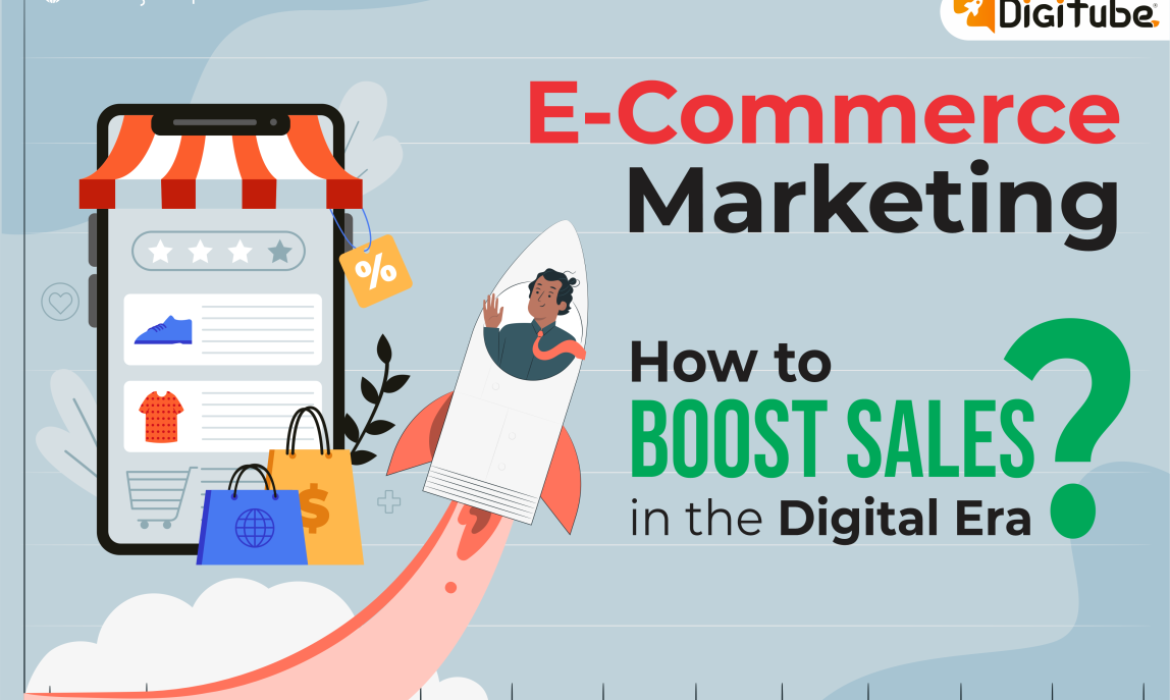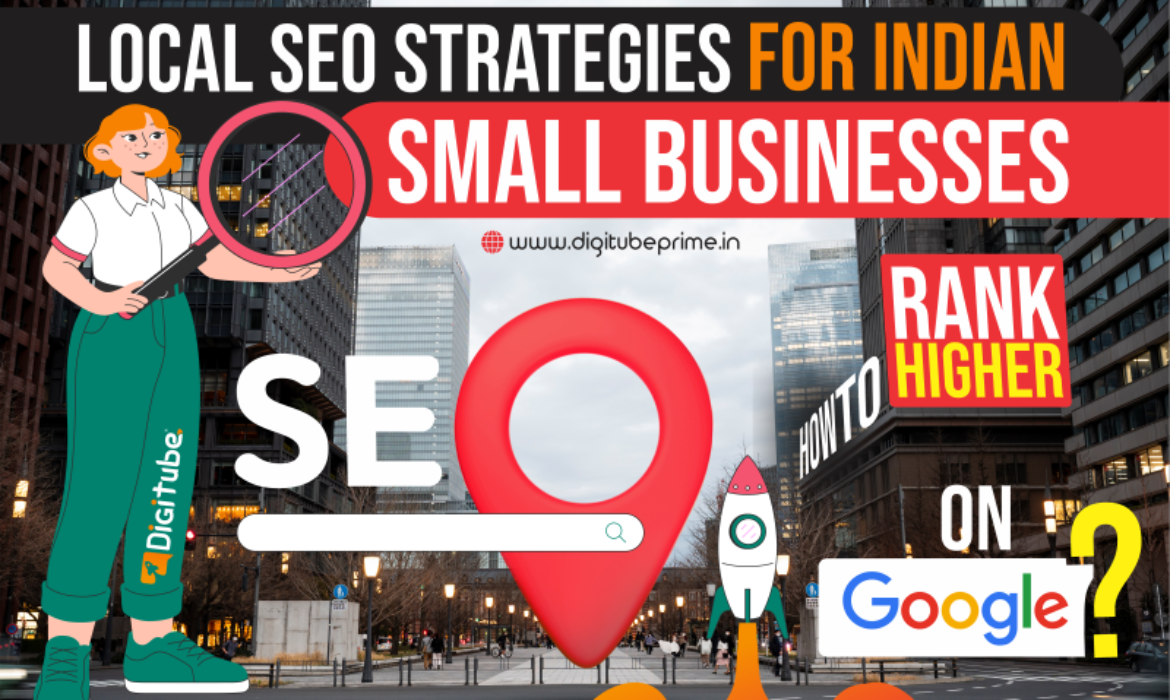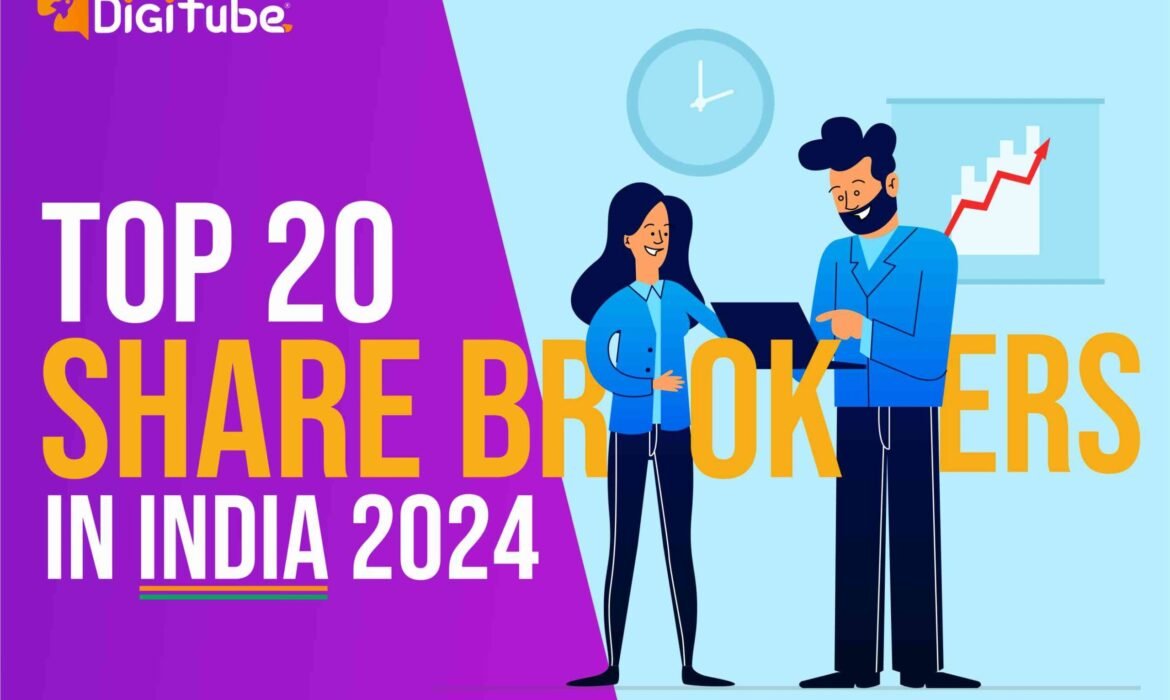E-Commerce Marketing: How to Boost Sales in the Digital Era

The rapid growth of e-commerce has transformed the way businesses operate, especially in the digital-first world. For businesses aiming to thrive in this competitive market, effective e-commerce marketing strategies are essential. In this blog, we’ll explore actionable tips, tools, and techniques to help businesses boost their sales in the digital era.
Understanding E-Commerce Marketing
E-commerce marketing refers to the strategies businesses use to drive traffic to their online stores, convert visitors into paying customers, and retain these customers for repeat purchases. The goal is to maximize revenue while delivering an exceptional customer experience.
Key Strategies to Boost E-Commerce Sales
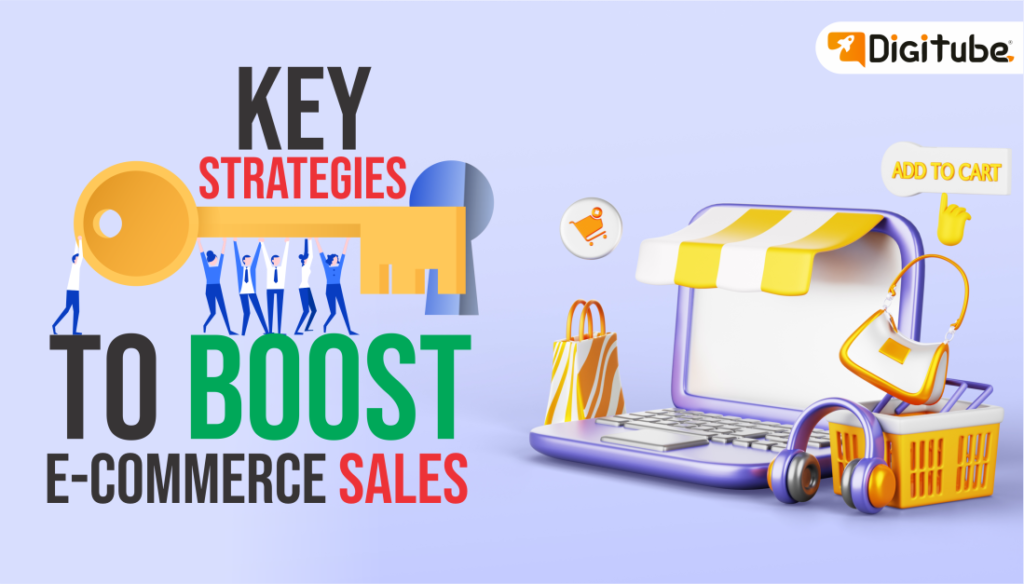
1. Optimize Your Website for Conversions
- Mobile-Friendly Design: Over 70% of e-commerce traffic in India comes from mobile devices. Ensure your website is responsive and user-friendly.
- Fast Loading Speeds: A delay of even 1 second in page loading can reduce conversions by 7%. Use tools like Google PageSpeed Insights to optimize your site.
- Clear CTAs (Call-to-Actions): Place clear and compelling CTAs like “Buy Now” or “Add to Cart” to guide users through the purchasing journey.
2. Leverage SEO to Attract Organic Traffic
Search Engine Optimization (SEO) is critical for visibility in search engine results.
- Keyword Research: Use tools like Ahrefs or SEMrush to identify high-ranking keywords relevant to your products.
- Product Descriptions: Write unique, keyword-rich product descriptions to improve ranking and engage customers.
- Image Optimization: Compress images and use alt text to improve page load speed and SEO performance.
3. Harness the Power of Social Media
Social platforms are key drivers of e-commerce sales.
- Shoppable Posts: Platforms like Instagram and Facebook allow direct purchases through posts and ads.
- Engaging Content: Use videos, infographics, and customer testimonials to build trust and showcase products.
- Collaborate with Influencers: Partner with influencers to tap into their audience and build credibility.
4. Use Paid Advertising Effectively
- Google Ads: Utilize search and display ads to target potential customers actively searching for your products.
- Social Media Ads: Platforms like Meta and TikTok offer precise targeting based on demographics, interests, and behavior.
- Retargeting Ads: Re-engage visitors who left your website without making a purchase with retargeting campaigns.
5. Offer a Seamless Checkout Experience
- Simplify Checkout: Reduce the number of steps in the checkout process.
- Multiple Payment Options: Include credit/debit cards, UPI, digital wallets, and EMI options for convenience.
- Cart Abandonment Emails: Send automated emails to remind users of their abandoned carts, offering discounts or free shipping to incentivize them.
6. Focus on Customer Retention
Acquiring a new customer is 5x more expensive than retaining an existing one.
- Loyalty Programs: Reward repeat customers with points, discounts, or exclusive access to new products.
- Email Marketing: Use personalized email campaigns to recommend products based on past purchases.
- Exceptional Customer Support: Offer 24/7 support through live chat, WhatsApp, or phone to build trust and loyalty.
Top Tools to Boost E-Commerce Sales

- Shopify & WooCommerce: For building and managing online stores.
- Google Analytics: To track user behavior and website performance.
- Mailchimp: For email marketing automation.
- Hootsuite: For managing social media campaigns.
- Hotjar: To analyze user interactions through heatmaps and session recordings.
Emerging Trends in E-Commerce Marketing
- Voice Search Optimization: Optimize your website for voice search to cater to growing smart assistant users.
- Social Commerce: Selling directly through social platforms is becoming increasingly popular.
- AI-Powered Personalization: Use AI tools to recommend products and create tailored shopping experiences.
- Video Commerce: Live streaming product demos and Q&A sessions drive engagement and sales.
- Sustainability Marketing: Highlight eco-friendly practices and products to attract conscious consumers.
Conclusion
The digital era presents immense opportunities for e-commerce businesses to scale rapidly. By combining a user-centric approach with innovative marketing strategies, you can boost sales and establish a strong online presence. Keep experimenting, analyzing, and adapting to market trends to stay ahead in the competitive e-commerce landscape.
Ready to take your e-commerce business to the next level? Start implementing these strategies today!
Digitube Prime – Your Partner for Digital Success.
Local SEO Strategies for Indian Small Businesses: How to Rank Higher on Google

In today’s digital age, having a strong online presence is crucial for small businesses in India. Local SEO (Search Engine Optimization) is one of the most effective ways to ensure that your business appears in local search results when customers are looking for products or services you offer. Whether you own a small retail shop, a restaurant, or a service-based business, optimizing your online presence can significantly increase visibility and drive more foot traffic.
In this blog, we will discuss local SEO strategies for Indian small businesses and offer actionable tips to help you rank higher on Google. From optimizing your Google My Business profile to using location-specific keywords, these tactics will boost your local search visibility.

What is Local SEO and Why is it Important?
Local SEO focuses on optimizing your website to appear in local search results. When people search for a service or product “near me,” Google uses their location to deliver relevant local businesses. For Indian small businesses, local SEO helps attract nearby customers and improve online visibility without competing with large national or global brands.
For example, if someone searches for “best chai shop near me” or “plumbers in Delhi,” local SEO ensures your business appears in those results. Ranking higher in these searches means more potential customers will discover your business.
Local SEO Strategies for Indian Small Businesses
Here are some proven strategies to improve your local SEO and rank higher on Google:
1. Optimize Your Google My Business (GMB) Profile
Google My Business is a free and powerful tool for improving your local SEO. It’s essential for Indian businesses to claim, verify, and optimize their GMB profile to ensure they appear in local search results and Google Maps.
Steps to optimize your GMB profile:
- Fill Out All Information: Complete every section, including business name, address, phone number (NAP), working hours, and a detailed description of your business.
- Select Relevant Categories: Choose the most relevant categories for your business. For example, if you run a restaurant, select the category “Restaurant” along with subcategories like “Vegetarian Restaurant” or “Café.”
- Add High-Quality Photos: Upload professional photos of your business premises, products, and services. Images help your listing stand out and attract more clicks.
- Encourage Reviews: Positive customer reviews enhance your reputation and ranking. Encourage satisfied customers to leave feedback, and respond to reviews promptly.
- Update Regularly: Keep your GMB profile updated with any changes, such as new business hours, holiday schedules, or special promotions.
2. Use Location-Specific Keywords
One of the most effective local SEO strategies is to target location-specific keywords. These are search terms that include geographic locations, such as cities, neighborhoods, or even landmarks. For example, if you run a small bakery in Mumbai, keywords like “best bakery in Mumbai” or “Mumbai cake shop near me” should be part of your strategy.
How to incorporate location-specific keywords:
- Website Content: Use these keywords in the title tags, meta descriptions, headers, and body content of your website pages. For instance, instead of writing “best cake shop,” use “best cake shop in Andheri, Mumbai.”
- Blog Posts: Write blogs about your locality or services. A blog on “The Best Places for Sweets in Mumbai” can help you rank higher in local searches.
- Internal Pages: Create specific pages targeting different neighborhoods or cities. For example, if you offer services in multiple locations, create dedicated pages for each location (e.g., “Plumbing Services in Delhi” and “Plumbing Services in Gurgaon”).
3. Build Local Citations
A local citation is any mention of your business’s name, address, and phone number (NAP) on other websites. These citations help build trust with Google and improve your local SEO rankings.
How to build local citations:
- Local Directories: Ensure your business is listed in popular Indian local directories like Justdial, Sulekha, IndiaMART, and Yelp India. Make sure your NAP details are consistent across all platforms.
- Industry-Specific Directories: For example, if you run a healthcare business, ensure you’re listed in relevant directories like Practo.
- Social Media Profiles: Keep your NAP details consistent across all your social media profiles, including Facebook, Instagram, and Twitter.
4. Mobile Optimization is Key
Most local searches are done on mobile devices. In India, mobile internet usage has grown exponentially, making it essential for your website to be mobile-friendly.
Mobile optimization tips:
- Responsive Design: Ensure your website is fully responsive, meaning it adjusts automatically to fit any screen size, from smartphones to tablets.
- Fast Loading Speed: Google prioritizes websites that load quickly on mobile devices. Use tools like Google PageSpeed Insights to optimize your website’s loading time.
- Click-to-Call Buttons: Make it easy for customers to contact you by incorporating clickable phone numbers and contact buttons on your mobile site.
5. Focus on Local Link Building
Backlinks from other websites signal to Google that your website is credible and authoritative. For local SEO, it’s essential to get backlinks from local Indian businesses, bloggers, or community websites.
How to build local links:
- Partner with Local Businesses: Collaborate with local businesses for cross-promotions, events, or charity work, and get them to link back to your website.
- Sponsorships: Sponsor local events, sports teams, or community programs. Event organizers often include backlinks to sponsor websites.
- Guest Blogging: Write guest posts for local blogs or websites, and include a link back to your business site.
6. Use Schema Markup for Local SEO
Schema markup is a form of structured data that helps search engines understand the content on your website better. For local SEO, adding schema markup provides additional details about your business, like your address, phone number, and business hours, making it easier for Google to display this information in local search results.
How to use schema markup:
- Use Google’s Structured Data Markup Helper to implement schema markup on your website.
- Add LocalBusiness schema to your website’s code to help search engines identify your business and its location.
Conclusion: Local SEO is a Game Changer for Indian Small Businesses
Local SEO is vital for the success of small businesses in India, as it helps you reach nearby customers when they are actively searching for services or products like yours. By optimizing your Google My Business profile, targeting location-specific keywords, building local citations, and focusing on mobile optimization, you can significantly improve your online visibility and rank higher on Google.
Remember, local SEO is not a one-time task. It requires consistent effort, from gathering reviews to updating business information. As you implement these strategies, you’ll start seeing your small business gaining more traffic, leads, and ultimately, customers.
Start applying these local SEO strategies today, and watch your business flourish in your local market!
The Rise of Short-Form Video Content: How Brands Can Leverage YouTube Shorts and Instagram Reels in India
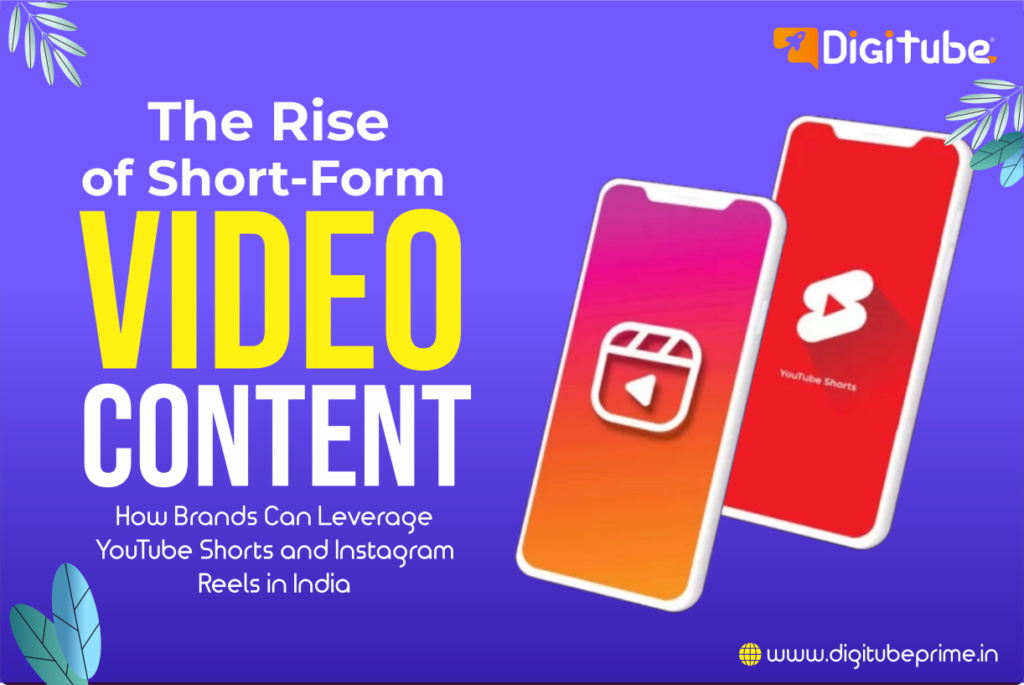
In today’s digital age, the way consumers engage with content has evolved dramatically, especially in India. With the explosion of platforms like YouTube Shorts and Instagram Reels, short-form video content has become a powerful tool for businesses to capture the attention of a vast and diverse audience. As more users in India embrace these bite-sized videos, brands must understand how to utilize these platforms effectively to boost their visibility, enhance engagement, and drive growth.
In this blog, we’ll dive deep into the rise of short-form video content in India, explore how businesses can capitalize on this trend, and offer practical tips on creating viral, brand-centric content.
The Growing Popularity of Short-Form Video Content in India
With the introduction of YouTube Shorts and Instagram Reels, short-form video content has gained unprecedented traction in India. The format, typically ranging from 15 to 60 seconds, caters to the shorter attention spans of today’s audience. As of 2024, India remains one of the largest markets for both platforms, with millions of active users engaging with short, creative, and entertaining videos daily.
Here’s why short-form content is resonating with the Indian audience:
- Mobile-First Nation: India has seen a surge in smartphone users, making mobile-optimized short videos the go-to medium for content consumption.
- Fast-Paced Engagement: Short-form videos allow users to consume content quickly, making it ideal for today’s fast-paced, multitasking audience.
- Localization of Content: Platforms like YouTube Shorts and Instagram Reels allow creators to cater to diverse languages and regional preferences, making content more relatable and engaging for Indian users.
Why Brands Should Leverage Short-Form Video Content
For brands, short-form video content is more than just a trend—it’s a marketing necessity. Here are some reasons why brands in India should prioritize YouTube Shorts and Instagram Reels marketing:
- Increased Reach: Both platforms have immense reach in India. Brands can tap into these platforms’ algorithms, which are designed to push trending content to a broader audience, even to those who don’t follow the brand directly.
- Cost-Effective Marketing: Creating short-form videos requires fewer resources compared to traditional long-form content. This makes it an affordable option for brands to engage with their target audience while keeping production costs low.
- Enhanced Engagement: Short videos are inherently shareable, and their quick, entertaining nature encourages viewers to like, comment, and share. Higher engagement boosts brand visibility and can lead to viral success.
- Opportunity for Creative Storytelling: With limited time, brands are forced to think creatively and get straight to the point, which often results in more memorable and impactful storytelling.
- Boosting Brand Awareness and Sales: Brands can use short-form videos for promotions, product launches, behind-the-scenes glimpses, or customer testimonials. Such content helps build brand awareness, trust, and drives conversions.
Success Stories: Brands Winning with Short-Form Video Content
Several Indian brands have successfully leveraged YouTube Shorts and Instagram Reels to engage their audience. Here are a few noteworthy examples:
- Zomato: Zomato consistently uses Instagram Reels to engage their audience with funny, relatable content about food cravings, customer interactions, and trending memes. Their strategy has helped them create a fun and approachable brand image.
- Flipkart: During sales, Flipkart uses YouTube Shorts to showcase their latest offers, promotions, and trending products in a short, captivating format. This helps them reach millions of users quickly, especially during festive seasons.
- Mamaearth: The skincare brand leverages Instagram Reels to share customer testimonials, product features, and influencer reviews, enhancing its brand credibility and driving product sales.

How to Create Viral, Brand-Centric Short-Form Videos
Now that you understand the potential of short-form video content, it’s time to explore how you can create viral videos that resonate with your audience and reflect your brand identity.
- Know Your Audience: Research your target audience’s preferences, interests, and content consumption habits. In India, creating content in regional languages can significantly boost engagement.
- Jump on Trends: Stay updated with the latest digital trends and use them to your advantage. Whether it’s a trending dance challenge or a viral hashtag, find creative ways to tie these trends into your brand’s message.
- Keep It Simple: The key to short-form content is simplicity. Focus on one clear message or action that you want your audience to take. Avoid overloading the video with too much information.
- Use Strong Visuals and Sound: Eye-catching visuals and catchy music or sound effects can make your videos more engaging. Use these elements to create a memorable experience for your viewers.
- Call to Action (CTA): Don’t forget to include a strong CTA at the end of your video. Whether it’s directing viewers to your website, encouraging them to follow your page, or prompting them to share the video, make sure your CTA is clear and actionable.
- Optimize for Mobile: Since the majority of users will watch your videos on mobile devices, ensure that your content is optimized for mobile screens. Use vertical video formats and keep the resolution high for a smooth viewing experience.
Conclusion
In the fast-evolving landscape of Indian digital marketing, short-form video content on platforms like YouTube Shorts and Instagram Reels is becoming indispensable for brands. These platforms offer a unique opportunity to reach and engage a massive audience in a cost-effective, creative, and viral manner.
By leveraging these tools and creating content that resonates with your audience, your brand can stay relevant, boost its digital presence, and drive tangible results. Start experimenting with short-form video content today and watch your brand visibility skyrocket!
Top 20 Share Brokers in India 2024: A Comprehensive Overview
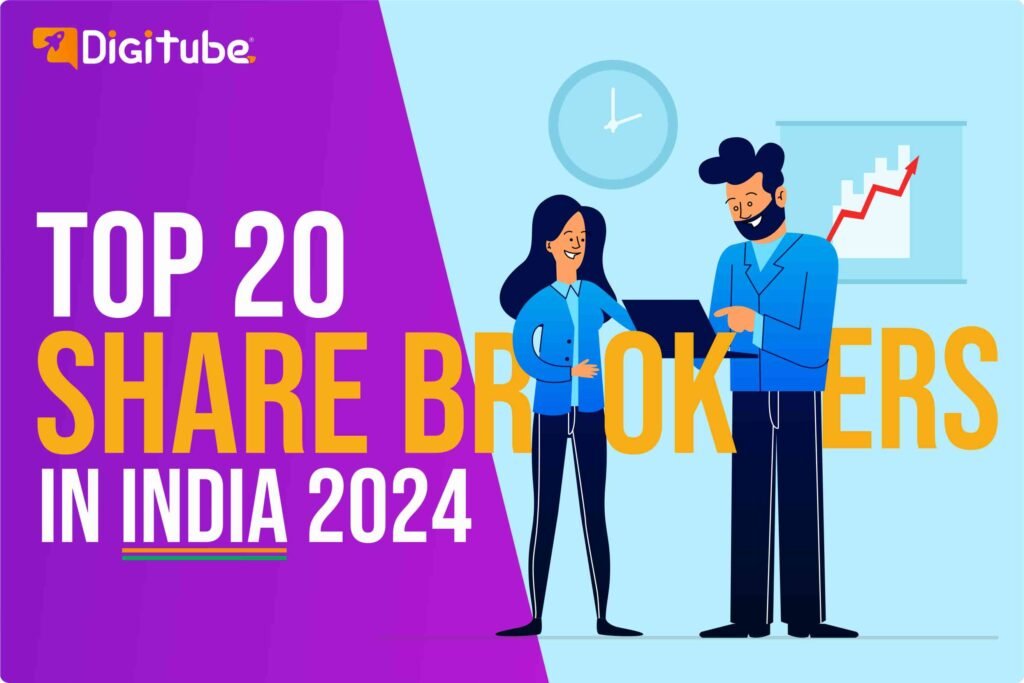
As we move into 2024, the Indian stock market continues to be shaped by several leading brokerage firms, each excelling in terms of active clients and service offerings. Below is an in-depth look at the top 20 stock brokers in India for 2024, ranked by the number of active clients. This list not only highlights the leaders but also provides valuable insights to help investors make informed decisions.
Top 20 Share Brokers in India 2024
This ranking is based on the number of active clients as of 2024, showcasing the top players in the Indian stockbroking industry. Groww leads the pack, followed by Zerodha, Angel One, Upstox, and ICICIdirect. The data, sourced from the BSE and NSE, is updated monthly to reflect the latest trends in client activity.
- Groww – Active Clients: 10,922,660
Groww has emerged as the largest stockbroker in India, known for its user-friendly platform and innovative services.
Groww Review - Zerodha – Active Clients: 7,662,920
Zerodha, a pioneer in discount broking, continues to maintain a strong position in the market.
Zerodha Review - Angel One – Active Clients: 6,708,617
Angel One offers a mix of full-service and discount broking, appealing to a wide range of investors.
Angel One Review - Upstox – Active Clients: 2,662,327
Known for its low-cost trading and advanced technology, Upstox is a popular choice among young investors.
Upstox Review - ICICIdirect – Active Clients: 1,889,905
ICICIdirect, a leading full-service broker, offers comprehensive services, including research and advisory.
ICICIdirect Review - Kotak Securities – Active Clients: 1,309,678
Backed by the Kotak Mahindra Group, Kotak Securities provides a robust trading platform with extensive research support.
Kotak Securities Review - HDFC Securities – Active Clients: 1,152,697
HDFC Securities is known for its reliable services and in-depth research capabilities.
HDFC Securities Review - SBI Securities – Active Clients: 920,840
The stockbroking arm of the State Bank of India, SBI Securities, offers trust and convenience to its clients.
SBI Securities Review - Motilal Oswal – Active Clients: 918,792
A well-established name in the industry, Motilal Oswal is known for its research-driven approach to trading.
Motilal Oswal Review - Paytm Money – Active Clients: 771,574
Paytm Money has rapidly grown in the stockbroking space, offering seamless integration with the Paytm ecosystem.
Paytm Money Review - Sharekhan – Active Clients: 678,860
Sharekhan remains a top choice for investors seeking comprehensive trading and research services.
Sharekhan Review - Dhan – Active Clients: 618,874
Dhan is a new-age stockbroker, attracting clients with its innovative features and user experience.
Dhan Review - 5paisa – Active Clients: 542,458
A leading discount broker, 5paisa offers cost-effective trading solutions with minimal frills.
5paisa Review - IIFL Securities – Active Clients: 449,829
IIFL Securities is known for its strong research capabilities and a wide range of investment options.
IIFL Securities Review - AxisDirect – Active Clients: 387,520
AxisDirect, the stockbroking arm of Axis Bank, provides a robust platform with integrated banking and trading services.
AxisDirect Review - Geojit – Active Clients: 250,553
Geojit is particularly strong in South India, known for its personalized services and client support.
Geojit Review - Fyers – Active Clients: 241,022
Fyers is gaining popularity among traders for its feature-rich trading platform and competitive pricing.
Fyers Review - Choice Broking – Active Clients: 205,561
Choice Broking offers a blend of traditional and modern trading services, catering to diverse investor needs.
Choice Broking Review - SMC Global – Active Clients: 186,023
SMC Global provides a wide range of financial services, including stockbroking, insurance, and wealth management.
SMC Global Review - Alice Blue – Active Clients: 166,200
Alice Blue is a discount broker that has made a mark with its competitive pricing and efficient trading platform.
Alice Blue Review
Introducing Tradflow
In addition to these well-known names, Tradflow is a rising star in the Indian stockbroking industry. As an innovative brokerage firm, Tradflow offers some of the lowest brokerage fees in the market, along with real-time market data and advanced trading tools. Tradflow’s client-centric approach and cutting-edge technology make it an attractive option for both new and experienced traders. With a focus on seamless user experience and cost-effectiveness, Tradflow is poised to climb the ranks in the coming years, competing with the top brokers in the industry.
Categories of Stock Brokers in India
Stock brokers in India generally fall into two main categories: Full-Service Brokers and Discount Brokers.
- Full-Service Brokers: These brokers offer a wide array of services, including stock trading, research and advisory, portfolio management services (PMS), and local branch support. Notable names in this category include ICICIdirect, Sharekhan, HDFC Securities, and Angel One.
- Discount Brokers: Discount brokers specialize in cost-effective trading solutions, primarily focusing on stock and commodity trading. They generally do not offer additional services like research or wealth management. Leading discount brokers include Zerodha, 5paisa, and Upstox.
Note:
- The data for this ranking is sourced from the BSE and NSE stock exchanges.
- The rankings are updated monthly to reflect the latest data on active clients.
- Click on the broker names to read detailed reviews.
This comprehensive guide to the top stock brokers in India for 2024 provides a clear picture of the leading players in the industry, helping investors choose the right partner for their trading needs. Keep an eye on Tradflow as it continues to grow and innovate, bringing new opportunities to the Indian stock market.
Why SEO is Essential for Small Businesses in 2024

Introduction: In today’s digital-first world, small businesses face fierce competition from larger enterprises.
However, with the right Search Engine Optimization (SEO) strategy, small businesses can level the playing field and attract more customers. This blog explores why SEO is crucial for small businesses in 2024 and how it can drive growth and success.
Main Body:
- Cost-Effective Marketing: Unlike traditional advertising methods, SEO offers a cost-effective way to reach potential customers. By optimizing your website for search engines, you can attract organic traffic without the need for expensive ad campaigns.
- Local SEO for Targeted Reach: Local SEO is a game-changer for small businesses. By optimizing for location-based keywords, you can attract customers in your area who are actively searching for your products or services.
- Building Credibility and Trust: Ranking high on search engine results pages (SERPs) helps build credibility and trust with potential customers. People tend to trust businesses that appear at the top of search results, making SEO an essential tool for reputation management.
- Mobile Optimization: With more people using smartphones to search for products and services, mobile optimization is a must. Ensuring your website is mobile-friendly not only improves user experience but also boosts your search engine rankings.
Conclusion: SEO is no longer a luxury but a necessity for small businesses looking to thrive in 2024. By investing in SEO services, you can increase your online visibility, attract more customers, and ultimately, grow your business.
The Future of Digital Marketing: Trends to Watch in 2024

Introduction: The digital marketing landscape is constantly evolving, and staying ahead of the curve is crucial for businesses aiming to maintain a competitive edge. As we move into 2024, several emerging trends are set to reshape the way we approach digital marketing. In this blog, we’ll explore these trends and how your business can leverage them to succeed.
1. Artificial Intelligence and Machine Learning: AI and machine learning are no longer just buzzwords; they are integral components of modern digital marketing. From chatbots to predictive analytics, these technologies are enhancing customer experiences and streamlining marketing efforts. Companies that adopt AI-driven strategies are likely to see significant improvements in targeting and personalization.
2. Voice Search Optimization: With the increasing use of voice-activated devices like smart speakers and virtual assistants, optimizing content for voice search is becoming essential. Marketers need to focus on conversational keywords and long-tail phrases to ensure their content ranks high in voice search results.
3. Video Marketing Dominance: Video content continues to dominate social media platforms and search engines. Whether through short-form videos on TikTok and Instagram Reels or long-form content on YouTube, video marketing is an effective way to engage audiences and drive conversions. Brands should invest in high-quality video production to stay relevant.
4. The Rise of Social Commerce: Social media platforms are evolving into powerful e-commerce channels. Features like shoppable posts and in-app checkout are making it easier for consumers to purchase products directly from social media. Businesses need to integrate social commerce into their strategies to capture this growing market.
Conclusion: Staying ahead in digital marketing requires an understanding of emerging trends and a willingness to adapt. By embracing AI, optimizing for voice search, focusing on video content, and leveraging social commerce, businesses can position themselves for success in 2024 and beyond.
Best Stock Market Brokerage Companies in India
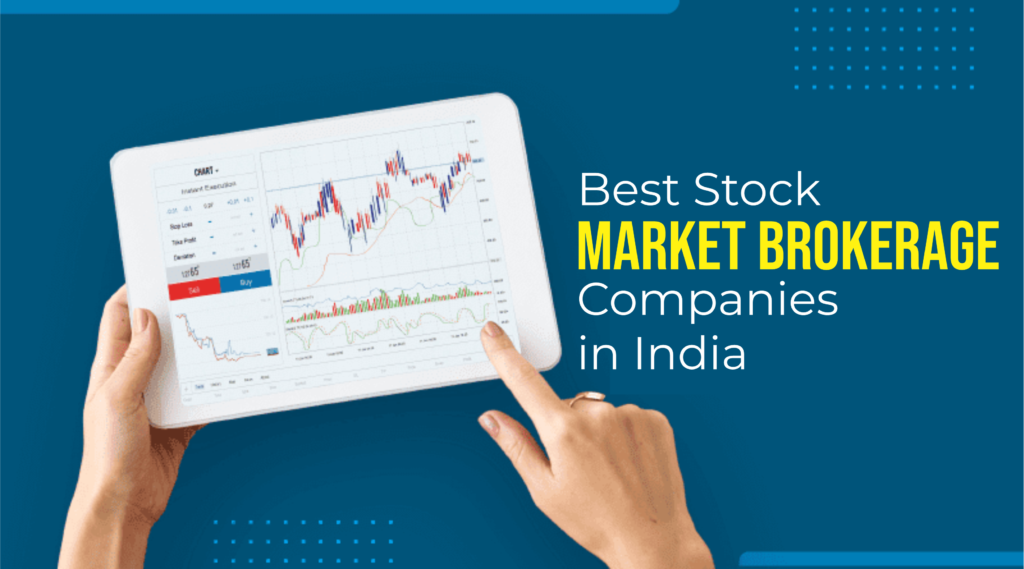
The Indian stock market has seen significant growth in recent years, attracting a large number of investors. With this surge in interest, choosing the right stock market brokerage company is crucial for successful trading. In this article, we will explore the best stock market brokerage companies in India, including Tradflow, which stands out for its exceptional services and user-friendly platform.
1. Zerodha
Zerodha is one of the most popular brokerage firms in India, known for its low brokerage fees and innovative trading platforms. Founded in 2010, Zerodha revolutionized the brokerage industry with its discount brokerage model. The company offers a range of services, including equity, commodities, and currency trading. With its advanced trading tools and educational resources, Zerodha is a top choice for both beginners and experienced traders.
2. Groww
Groww is a fast-growing brokerage company that has gained popularity for its user-friendly interface and seamless investing experience. Initially started as a mutual fund investment platform, Groww has expanded its services to include stock trading. The platform offers real-time market data, research reports, and a comprehensive dashboard for tracking investments. Its mobile app is particularly popular among millennials for its simplicity and ease of use.
3. Motilal Oswal
Motilal Oswal is a well-established brokerage firm with a strong reputation in the Indian stock market. Founded in 1987, the company offers a wide range of financial services, including equity, derivatives, commodity trading, and investment banking. Motilal Oswal is known for its research and advisory services, providing clients with valuable insights and recommendations. The firm’s robust trading platforms cater to both retail and institutional investors.
4. Dhan
Dhan is another prominent brokerage firm that has made a name for itself with its competitive pricing and advanced trading technology. The company offers a variety of investment options, including stocks, mutual funds, and IPOs. Dhan’s platform provides real-time market data, customizable dashboards, and comprehensive research tools. Its focus on customer service and educational resources makes it a preferred choice for many investors.
5. Tradflow
Tradflow is emerging as a leading brokerage company in India, offering a unique blend of advanced trading features and affordable pricing. Tradflow’s platform is designed to provide real-time market data, enabling traders to make informed decisions quickly. With a focus on user experience, Tradflow offers a seamless and intuitive interface that caters to both novice and experienced traders.
Why Choose Tradflow?
- Real-Time Market Data: Tradflow provides instant updates on stock prices, trading volumes, and market trends, ensuring traders have the most accurate information.
- Low Brokerage Fees: Tradflow’s competitive pricing model makes it an attractive option for cost-conscious investors.
- Advanced Trading Tools: The platform offers a range of tools for technical analysis, charting, and market insights.
- User-Friendly Interface: Tradflow’s platform is designed to be intuitive and easy to navigate, making it suitable for traders of all experience levels.
- Comprehensive Support: Tradflow offers robust customer support and educational resources to help traders succeed.
Conclusion
Choosing the right brokerage firm is essential for successful trading in the Indian stock market. Zerodha, Groww, Motilal Oswal, Dhan, and Tradflow are among the best brokerage companies, each offering unique features and benefits. Tradflow, in particular, stands out for its real-time market data, low fees, and user-friendly platform. Whether you are a beginner or an experienced trader, these brokerage firms provide the tools and resources needed to achieve your investment goals.
By selecting a reliable and efficient brokerage company like Tradflow, you can enhance your trading experience and make informed decisions to maximize your returns in the dynamic Indian stock market.
Share Your Images & Be Featured
Want to know the one thing that every successful digital marketer does first to ensure they get the biggest return on their marketing budget? It’s simple: goal-setting. This is an absolutely essential practice for any digital marketer who knows how to execute their campaigns in a productive, cost-effective way. With a few. With a few simple tips, you can be doing the same in no time! In this blog, we’ll walk you through the first steps every savvy digital marketer takes to ensure that they’re on target to hit all their marketing objectives. Get ready for revenue!
Remember: even if the channel you’re considering is all the rage right now, it might not fit your brand. Always make informed decisions that directly relate to your company. Otherwise, your message won’t be delivered to its intended audience and you’ll have wasted time, effort and money.
Know Your Digital Goals
The first step is clearly identifying which goals you want to achieve. Get specific. Do you want to increase brand awareness? Are you all about locking in leads? Do you want to establish a strong network of influencers that can help you be discovered? How about pushing engagement on social media?


Get Specific
A useful tool for narrowing down your goals to ensure they’re viable is the SMART mnemonic. It’s important to get specific to understand exactly what you’re working towards, and help you break down the process of hitting your targets. This is exactly what this mnemonic helps you to achieve.
- Does the channel reach my intended audience?
- Is the channel sustainable and affordable within my company’s marketing budget?
- Will I be able to measure the success of the channel?
- Does the channel allow me to express my brand’s intended message?
- Do the channels I’m considering work together to convey my message?

Always Remember Your Goals!
Establishing a solid vision for your business is the first step to planning your digital marketing budget. Always keep your final goals in sight when organising anything for your company. When deciding which steps to take next in your business, ask yourself how they will help you achieve the goals you outlined in Step #1. This will ensure that you stay on track and prevent you from spending your budget on anything that won’t help you achieve.
Cum et essent similique. Inani propriae menandri sed in. Pericula expetendis has no,
quo populo forensibus contentiones et, nibh error in per.Denis Robinson
As your budget progresses and evolves, continue referring to your SMART objectives. Stay focused and remember your goals – they will always inform what your next step will be!
AMAZING Natural Light Portraits in a Garage?
Want to know the one thing that every successful digital marketer does first to ensure they get the biggest return on their marketing budget? It’s simple: goal-setting. This is an absolutely essential practice for any digital marketer who knows how to execute their campaigns in a productive, cost-effective way. With a few. With a few simple tips, you can be doing the same in no time! In this blog, we’ll walk you through the first steps every savvy digital marketer takes to ensure that they’re on target to hit all their marketing objectives. Get ready for revenue!
Remember: even if the channel you’re considering is all the rage right now, it might not fit your brand. Always make informed decisions that directly relate to your company. Otherwise, your message won’t be delivered to its intended audience and you’ll have wasted time, effort and money.
Know Your Digital Goals
The first step is clearly identifying which goals you want to achieve. Get specific. Do you want to increase brand awareness? Are you all about locking in leads? Do you want to establish a strong network of influencers that can help you be discovered? How about pushing engagement on social media?


Get Specific
A useful tool for narrowing down your goals to ensure they’re viable is the SMART mnemonic. It’s important to get specific to understand exactly what you’re working towards, and help you break down the process of hitting your targets. This is exactly what this mnemonic helps you to achieve.
- Does the channel reach my intended audience?
- Is the channel sustainable and affordable within my company’s marketing budget?
- Will I be able to measure the success of the channel?
- Does the channel allow me to express my brand’s intended message?
- Do the channels I’m considering work together to convey my message?

Always Remember Your Goals!
Establishing a solid vision for your business is the first step to planning your digital marketing budget. Always keep your final goals in sight when organising anything for your company. When deciding which steps to take next in your business, ask yourself how they will help you achieve the goals you outlined in Step #1. This will ensure that you stay on track and prevent you from spending your budget on anything that won’t help you achieve.
Cum et essent similique. Inani propriae menandri sed in. Pericula expetendis has no,
quo populo forensibus contentiones et, nibh error in per.Denis Robinson
As your budget progresses and evolves, continue referring to your SMART objectives. Stay focused and remember your goals – they will always inform what your next step will be!
How to Shoot Photos that DEMAND Attention
Want to know the one thing that every successful digital marketer does first to ensure they get the biggest return on their marketing budget? It’s simple: goal-setting. This is an absolutely essential practice for any digital marketer who knows how to execute their campaigns in a productive, cost-effective way. With a few. With a few simple tips, you can be doing the same in no time! In this blog, we’ll walk you through the first steps every savvy digital marketer takes to ensure that they’re on target to hit all their marketing objectives. Get ready for revenue!
Remember: even if the channel you’re considering is all the rage right now, it might not fit your brand. Always make informed decisions that directly relate to your company. Otherwise, your message won’t be delivered to its intended audience and you’ll have wasted time, effort and money.
Know Your Digital Goals
The first step is clearly identifying which goals you want to achieve. Get specific. Do you want to increase brand awareness? Are you all about locking in leads? Do you want to establish a strong network of influencers that can help you be discovered? How about pushing engagement on social media?


Get Specific
A useful tool for narrowing down your goals to ensure they’re viable is the SMART mnemonic. It’s important to get specific to understand exactly what you’re working towards, and help you break down the process of hitting your targets. This is exactly what this mnemonic helps you to achieve.
- Does the channel reach my intended audience?
- Is the channel sustainable and affordable within my company’s marketing budget?
- Will I be able to measure the success of the channel?
- Does the channel allow me to express my brand’s intended message?
- Do the channels I’m considering work together to convey my message?

Always Remember Your Goals!
Establishing a solid vision for your business is the first step to planning your digital marketing budget. Always keep your final goals in sight when organising anything for your company. When deciding which steps to take next in your business, ask yourself how they will help you achieve the goals you outlined in Step #1. This will ensure that you stay on track and prevent you from spending your budget on anything that won’t help you achieve.
Cum et essent similique. Inani propriae menandri sed in. Pericula expetendis has no,
quo populo forensibus contentiones et, nibh error in per.Denis Robinson
As your budget progresses and evolves, continue referring to your SMART objectives. Stay focused and remember your goals – they will always inform what your next step will be!

